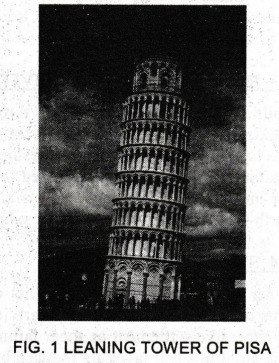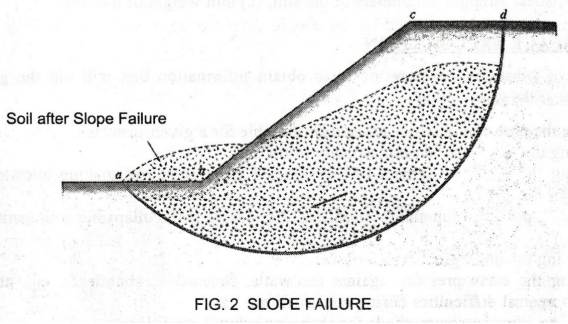Basic Civil & Mechanical Engineering: UNIT I: d. Geotechnical engineering
Aspects of geotechnical engineering
During the planning, design, and construction of foundation, embankments, and earth-retaining structures, engineers find it helpful to know the origin of the soil deposit over which the foundation is to be constructed.
ASPECTS OF GEOTECHNICAL ENGINEERING
1. SOIL DEPOSITS
During
the planning, design, and construction of foundation, embankments, and
earth-retaining structures, engineers find it helpful to know the origin of the
soil deposit over which the foundation is to be constructed. It is because each
soil deposit has its own unique physical attributes.
The
primary mechanism of soil creation is the weathering of rock. There are two
general types of weathering, viz., Mechanical weathering and Chemical
weathering.
Mechanical
weathering is the process by which rocks are broken
into smaller and smaller pieces by physical forces including running water,
wind, ocean waves, glacier ice, frost, and expansion and contraction caused by
the gain and loss of heat.
Chemical
weathering is the process of chemical decomposition
of the original rock. In the case of mechanical weathering, the rock breaks
into smaller pieces without a change in the chemical composition. However, in
chemical weathering, the original material may be changed to something entirely
different. For example, the chemical weathering of feldspar can produce clay
minerals. Rock weathering is mostly a combination of mechanical and chemical
weathering.
Soils
as they are found in different regions can be classified into two broad
categories, viz., (i) Residual soils and (ii) Transported soils. Residual soils
exist at the same location as the rock from which they were formed. Decomposed
granite is a common example for residual soil.
Generally,
the depth of residual soils varies from 5 to 20 m. Residual soils show
considerable variation of engineering properties form top layer to bottom
layer. The transition observed is gradual. Relatively finer materials are found
near ground surface and they become coarser with depth to reach larger fragment
of stone.;
Transported
soils form from weathered material deposits, which are
transported by natural forces to a new site, away from the site of origin. The
type of transport soil is determined by the agent, such as wind, water, ice or
snow that assists in its transportation.
2. SOIL COMPACTION
In
the construction of highway embankments, earth dams, and many other engineering
structures, loose soils must be compacted to increase their unit weights.
Compaction increases the strength characteristics of soils. Hence, it increases
the bearing capacity of foundation constructed over them. Compaction also
decreases the amount of undesirable settlements of structures and increases the
stability of slopes of embankments.
Smooth-wheel
rollers, sheep foot rollers, rubber-tired rollers, and vibratory rollers are
generally used in the field for soil compaction. Vibratory rollers are used
mostly for the densification of granular soils.
3. HYDRAULIC CONDUCTIVITY AND SEEPAGE
Soils
have interconnected voids through which water can flow from points of high
energy to points of low energy. A study on the flow of water through porous
soil media is important in soil mechanics. It is necessary for estimating the
quantity of underground seepage under various hydraulic conditions. It is
required for investigation of problems involving the pumping of water for
underground construction. It is also required for making stability analysis of
earth dams and earth-retaining structures that are subjected to seepage forces.
4. STRESSES IN SOIL
When
a building is constructed, its weight is transmitted to the ground through its
foundation, thus inducing stresses in the underlying strata. These induced
stresses might cause problems such as excessive settlement or shear failure and
thus are important to geotechnical engineers. Stresses at a point in a soil
layer are induced by:
(i)
Self-weight of the soil layers (Geostatic stresses) and
(ii)
Added load (such as buildings, bridges, dams, etc.)
The
vertical geostatic stresses increase with depth. As the stress increases in the
soil, the soil can be deformed by the stress.
Soils
are multiphase systems. In a given volume of soil, the solid particles are
distributed randomly with void spaces in between. The void spaces are
continuous and are occupied by water, air or both. When a load is applied to
soil, it is carried by the water in the pores as well as the solid grains.
5. COMPRESSIBLITY OF SOIL
A
stress increase caused by the construction of foundation or other loads
compress the soil layers. The compression of soil is caused by
1.
Deformation of particles
2.
Relocation of soil particles
3.
Expulsion of water or air from the void spaces
In
general, the soil settlement caused by load may be divided into three broad
categories:
1)
Immediate settlement: It is caused by the elastic
deformation of soils without any change in the moisture content.
2)
Primary consolidation settlement: It is the result of a
volume change in soils because of the expulsion of water that occupies the void
spaces.
3)
Secondary consolidation settlement: It follows the primary
consolidation settlement under a constant stress.
The
total settlement of a foundation is the sum of above three settlements. When
foundations are constructed on very compressible clay, the consolidation
settlement can be several times greater than immediate settlement.
The
leaning tower of Pisa is the classic example of differential settlement (Fig.
1). The failure is primarily due to the location of the tower and the
instability of the ground underneath the foundation.

The
weight of the tower compressed the ground beneath beginning with a seven meter
fayer of silt and thirty meters of clay under the foundation. An area of clay
under the south side of the structure is softer than its counterparts causing
the infamous lean towards the south. Further depression of the clay below the
foundation is a result of consolidation.
6. SHEAR STRENGTH OF SOIL
The
shear strength of a soil mass is the internal resistance per unit area that the
soil mass can offer to resist failure and sliding along any plane inside it. It
is primarily derived from friction between the particles and interlocking.
Engineers must understand the nature of shearing resistance in order to analyse
soil stability problems such as bearing capacity, slope stability and lateral
pressure on earth-retaining structures.
7. SLOPE STABILITY
An
exposed ground surface that stands at an angle with the horizontal is called an
unrestrained slope. The slope can be natural or constructed. If the ground
surface is not horizontal, a component of gravity will cause the soil to move
downward, as shown in Fig. 1. If the component of gravity is large enough,
slope failure can occur; that is the soil mass in zone abcdea can slide
downward. The driving force overcomes the resistance from shear strength of the
soil along the rupture surface.

Civil
engineers often are expected to make calculations to check the safety of
natural slopes, slopes of excavations and compacted embankments. This check
involves determining the shear stress developed along the most likely rupture
surface and comparing it with the shear strength of the soil. This process is
called slope stability analysis. The most likely rupture surface is the
critical surface that has the minimum factor of safety.
Factor
of Safety
The
task of the civil engineer who analyses slope stability is to determine the
factor of safety,
fs
= qf / qd
where,
qf, = average shear strength of the soil
qd
= average shear stress developed along the potential failure surface
When
fs is equal to 1, the slope is about to fail. The acceptable factor of safety
is 1.5 for the design of a stable slope.
8. LATERAL EARTH PRESSURE
Retaining
structures such as retaining walls and basement walls are commonly encountered
in foundation engineering as they support slopes of earth masses. Proper design
and construction of these structures require a thorough knowledge of the
lateral forces that act between the retaining structures and the soil masses
being retained. These lateral forces are caused by lateral earth pressure.
Lateral
earth pressure is a function of several factors such as, (a) type and amount of
wall movement, (b) shear strength parameters of the soil, (c) unit weight of
the soil.
9. SUBSURFACE EXPLORATION
The
purpose of subsurface exploration is to obtain information that will aid the
geotechnical engineer in the tasks given below:
1.
Selecting the type and depth of foundation suitable for a given structure.
2.
Evaluating the safe load bearing capacity of the soil.
3.
Estimating the likely settlement of the selected foundation and making
allowance for the same in the design
4.
Determining potential foundation problems (Expansive soil, collapsible soil,
sanitary landfill and so on)
5.
Determining the underground water level.
6.
Evaluating the earth pressure against the walls, basements, abutments, etc. and
to make provision against difficulties during construction.
7.
Establishing construction methods for changing subsoil conditions
Subsurface
exploration is also necessary for underground construction and excavation. It
may be required when additions or alterations to existing structures are
contemplated. It usually ... involves soil sampling and laboratory tests of the
soil samples retrieved. The depth of exploration or a trial pit or bore hole
will depend upon the characteristics of the soil as well as the type of
structure, its shape, size and loading condition.
10. FOUNDATIONS - BEARING CAPACITY AND SETTLEMENT
The
lowest part of a structure is generally referred to as foundation. Its function
is to transfer the load of the structure to the soil on which it is resting. A
properly designed foundation is one that transfers the load throughout the soil
on which it is resting. It should ensure that load transfer does not overstress
the soil. Overstressing the soil can result in either excessive settlement or shear
failure of the soil, both of which cause damage to the structure.
The
geotechnical and structural engineers who design foundations must evaluate the
bearing capacity of soils. Depending on the structure and soil encountered,
various types of foundations are used. Further details on requirements of
foundations, foundation soils and types of foundation are provided in Chapter
5.
Basic Civil & Mechanical Engineering: UNIT I: d. Geotechnical engineering : Tag: : - Aspects of geotechnical engineering
Related Topics
Related Subjects
Basic Civil and Mechanical Engineering
BE3255 2nd Semester 2021 Regulation | 2nd Semester EEE Dept 2021 Regulation
